
Botrychium is a genus of ferns, seedless vascular plants in the family Ophioglossaceae. Botrychium species are known as moonworts. They are small, with fleshy roots, and reproduce by spores shed into the air. One part of the leaf, the trophophore, is sterile and fernlike; the other, the sporophore, is fertile and carries the clusters of sporangia or spore cases. Some species only occasionally emerge above ground and gain most of their nourishment from an association with mycorrhizal fungi.

Tibouchina Aubl. is a neotropical flowering plant genus in Melastomataceae Juss. that contains approximately 240 species. Species of this genus are herbs, shrubs or trees and typically have purple flowers. They are native to Mexico, the Caribbean, and South America where they are found as far south as northern Argentina. Members of this genus are known as glory bushes, glory trees or princess flowers. The name Tibouchina is adapted from a Guianan indigenous name for a member of this genus [2]. A recent systematic study has shown that this genus is paraphyletic.

Genlisea is a genus of carnivorous plants also known as corkscrew plants. The 30 or so species grow in wet terrestrial to semi-aquatic environments distributed throughout Africa and Central and South America. The plants use highly modified underground leaves to attract, trap and digest minute microfauna, particularly protozoans. Although suggested a century earlier by Charles Darwin, carnivory in the genus was not proven until 1998.
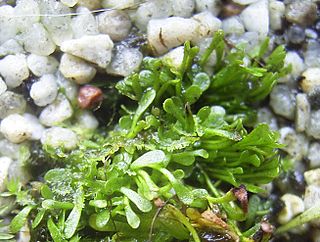
Genlisea aurea is one of the largest carnivorous species in the genus Genlisea. It has pale bundles of root-like organs up to about 15 cm long under ground that attract, trap, and digest protozoans. These organs are subterranean leaves, which lack chlorophyll. G. aurea is endemic to Brazil, where it grows with several other species of Genlisea. It possesses an exceptionally small genome for a flowering plant.

Polystichum is a genus of ferns in the family Dryopteridaceae, subfamily Dryopteridoideae, according to the Pteridophyte Phylogeny Group classification of 2016. The genus has about 500 species and has a cosmopolitan distribution. The highest diversity is in eastern Asia, with about 208 species in China alone; the region from Mexico to Brazil has at least 100 additional species; Africa, North America, and Europe have much lower diversity. Polystichum species are terrestrial or rock-dwelling ferns of warm-temperate and montane-tropical regions. They are often found in disturbed habitats such as road cuts, talus slopes, and stream banks.
Genlisea margaretae is a carnivorous species in the genus Genlisea native to areas of Madagascar, Tanzania, and Zambia. It has pale bundles of root-like organs up to about 20 cm long under ground that attract, trap, and digest protozoans. These organs are subterranean leaves, which lack chlorophyll. It had been known to possess the smallest known genome of any flowering plant as of 2006, but was later surpassed by the related species Genlisea tuberosa.
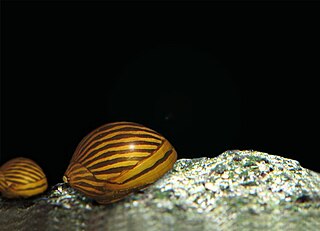
Neritina, is a genus of small aquatic snails with an operculum, marine, brackish water, and sometimes freshwater gastropod mollusks in the family Neritidae, the nerites.
Peter Geoffrey Taylor (1926–2011) was a British botanist who worked at Royal Botanic Gardens, Kew throughout his career in botany. Taylor was born in 1926 and joined the staff of the herbarium at Kew in 1948. He published his first new species, Utricularia pentadactyla, in 1954. In 1973, Taylor was appointed curator of the orchid division of the herbarium and, according to Kew, "under his direction, orchid taxonomy was revitalised and its horticultural contacts strengthened."
Lepidostephium is a genus of South African flowering plants in the daisy family, Asteraceae.
Macowania is a genus of African flowering plants in the pussy's-toes tribe within the sunflower family.
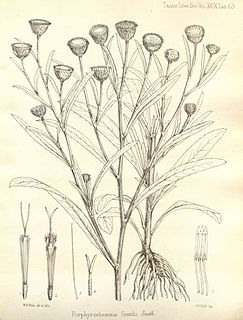
Porphyrostemma is a genus of African plants in the Irish fleabane tribe within the daisy family.
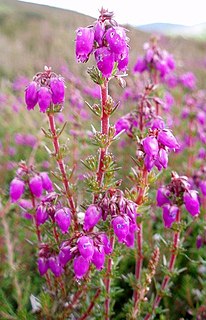
Edward (Ted) George Hudson Oliver, is a South African Botanist and author. He is an expert in heathers. He has discovered and named several species. Oliver is the recognized world authority on the subfamily Ericoideae.

Genlisea filiformis is a species of carnivorous plant in the genus Genlisea. It is native throughout the majority of South America, several countries in Mesoamerica, and the Caribbean.
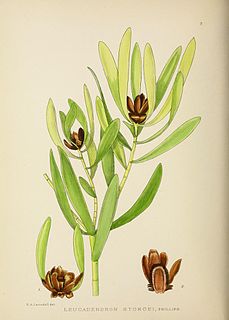
Leucadendron microcephalum is a dioecious, single-stemmed, South African shrub belonging to the family Proteaceae, endemic to the Western Cape and growing from sea level to 1200 m. It is one of some 200 species in the genus, all confined to South Africa.
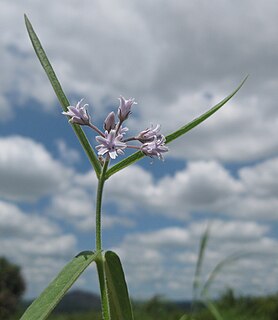
Margaretta is a genus of plants in the family Apocynaceae first described as a genus in 1875. A dozen names have been proposed as species within Margaretta, but at present only one, Margaretta rosea, is categorized as "accepted" by The Plant List. Most of the rest are "unresolved," in other words, of uncertain affinity. Margaretta rosea is native to Uganda in eastern Africa.
Chlorocyathus is a genus of plants in the Apocynaceae, first described in 1887. It is native to southern Africa.
- Chlorocyathus lobulata(Venter & R.L.Verh.) Venter - Bathurst District in Cape Province of South Africa
- Chlorocyathus monteiroaeOliv. - Maputo Bay in southern Mozambique
Petersianthus is a genus of woody plant in the Lecythidaceae family first described as a genus in 1865 under the name Petersia. This turned out to be an illegitimate homonym, meaning that it had already been used by someone else to refer to a very different plant. So the name of these species in the Lecythidaceae was changed to Petersianthus. It is native to the Philippines and to parts of Africa.
- Petersianthus macrocarpus(P.Beauv.) Liben - Guinea, Ivory Coast, Cameroon, Congo Republic, Democratic Republic of the Congo, Cabinda, Gabon, Angola
- Petersianthus quadrialatus(Merr.) Merr. - Philippines
Genlisea tuberosa is a carnivorous species in the genus Genlisea that is endemic to Brazil and found only in campos rupestres vegetation. Lacking any roots, it has unpigmented bundles of "rootlike" subterranean organs, technically leaves, which attract, trap, and digest protozoans. This species is unique in the genus in its formation of tubers. As of 2014, Genlisea tuberosa has the smallest known genome of any flowering plant, at 61 Mbp, or 61,000,000 base pairs.

Hypericum boreale, also known as northern St. John's-wort, is a short-lived perennial species of flowering plant in the family Hypericaceae, section Trigynobrathys.











